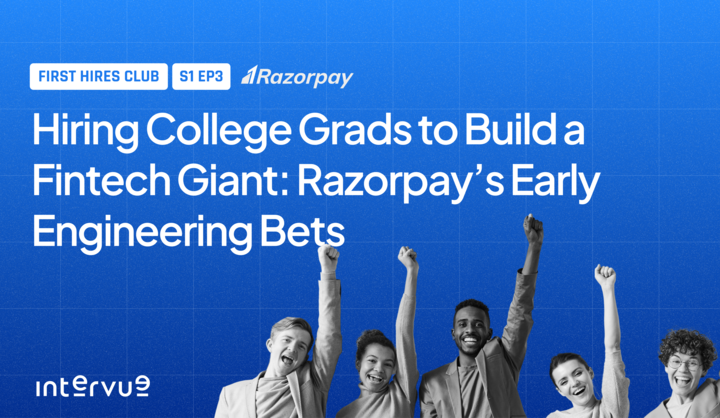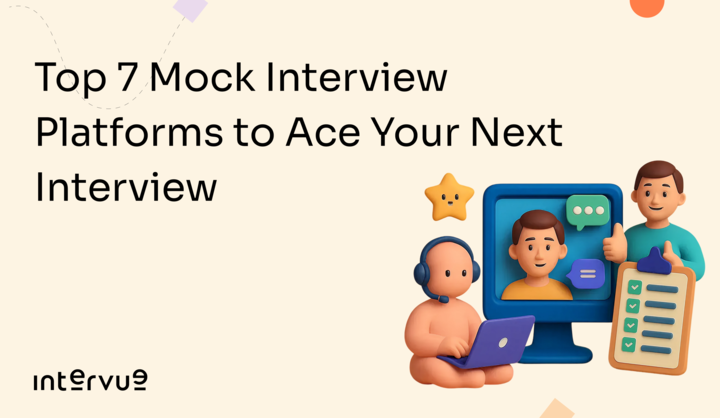Hiring College Grads to Build a Fintech Giant: Razorpay’s Early Engineering Bets
Looking back, Razorpay’s early hiring decisions followed an informal framework — one that aligns closely with how we design hiring processes for our clients.

At Intervue.io, we speak to hundreds of founders, CHROs, and engineering leaders every year about one of the hardest problems in building a company: hiring the first few engineers who will set the tone for everything that follows.
It’s not just about skill. It’s about culture, ownership, and the ability to thrive in the unpredictable chaos of an early-stage startup. Those first hires decide whether your company scales smoothly or stumbles early.
One of our favourite examples of getting this right is Razorpay. Today, they’re a household name in fintech. Back in 2014, there were two founders coding in a rented house, trying to convince people to join them instead of going to Amazon or Google.
Their early hiring strategy and the way they bet on college grads hold powerful lessons for any founder building a team from scratch. And it’s exactly the kind of talent philosophy we help companies implement at Intervue.io.
Why Your First Hires Matter More Than You Think
Hiring at the start is messy. You have no brand recognition. The risk of failure is high. The best candidates already have offers from bigger names.
This is why most first-time founders either hire too slowly because they’re chasing unicorn résumés, or too quickly because they want to fill seats. Both mistakes can be fatal.
Razorpay’s founders, Shashank Kumar and Harshil Mathur, were first-time founders too. They made their share of mistakes, but quickly learned a truth we at Intervue.io repeat often:
The first few hires are not about pedigree — they’re about potential, adaptability, and hunger.
Inside Razorpay’s Unlikely Talent Pool
Instead of competing for a narrow pool of “rockstar” engineers, Razorpay focused on finding high-quality generalists — people who could wear multiple hats and grow into the role.
They found them in their networks, at hackathons, in tech communities, and even among failed founders. Many were straight out of college. One took seven years to finish a four-year degree but had exceptional technical chops. Another was a hobbyist designer who became one of their best creative hires.
These hires weren’t just coders. They were problem solvers, testers, product thinkers, and customer champions rolled into one. The early Razorpay team operated without rigid roles, which meant every day was a crash course in building a business.
At Intervue.io, we see this same need in almost every early-stage company. The challenge is not just finding these people but identifying them reliably, especially when their CV doesn’t scream “obvious hire.”
Four Principles That Built a Fintech Powerhouse
Looking back, Razorpay’s early hiring decisions followed an informal framework — one that aligns closely with how we design hiring processes for our clients.
1. Hire for potential, not just skill: They looked for curiosity, problem-solving ability, and ownership. A candidate’s trajectory mattered more than their starting point.
2. Protect the hiring bar: They refused to lower standards to fill seats quickly. As Shashank puts it, A-players hire A-players. B-players hire C-players.
3. Cultural alignment first: In the early days, culture meant bias for action, comfort with ambiguity, and resilience under pressure. If someone needed structure and process to function, they wouldn’t thrive.
4. Hire ahead of the curve: Many early Razorpay hires were thrown into challenges far beyond their experience. The company trusted them to grow into those responsibilities — and they did.
This is not luck. It’s the result of a clear, deliberate mindset, supported by consistent evaluation criteria. That’s where many startups struggle — and where Intervue.io comes in.
Five Founder Tactics You Can Apply Right Now
Razorpay’s story proves that your first ten hires can shape your company’s destiny. Here are some principles we help founders put into practice:
- Start in your network, but don’t stay there. Tap friends and acquaintances for trust and speed, then widen the net using targeted outreach and community scouting.
- Assess for passion. It’s hard to fake genuine enthusiasm for technology or problem-solving. Ask candidates about projects they’ve built, even outside work or school.
- Simulate ambiguity. In interviews, give open-ended problems without perfect information. See how candidates react — do they freeze, or do they try something?
- Move at the right pace. Don’t overhire before you have product-market fit. Every early hire changes your culture.
- Keep building relationships. Some of your best future hires may not join immediately. Nurture those connections.
The cultural payoff
Razorpay’s early team didn’t just build product features — they built the company’s DNA.
Because they were trusted with ownership early, they developed into leaders who could guide the company through hypergrowth. Many are still with Razorpay today, shaping its next chapter.
When you get early hiring right, you create a team that’s not just executing tasks but actively steering the company’s direction. That’s what makes hiring the highest-leverage activity for any founder.
Intervue.io’s role in building tomorrow’s Razorpays
At Intervue.io, we don’t believe there’s a single “type” of perfect early hire. We believe in building a hiring system that can find your perfect early hire — the person who fits your stage, culture, and mission.
We help companies:
- Identify startup-ready talent, even without a conventional background
- Run consistent, bias-free evaluations that compare candidates fairly
- Spot hidden gems that might otherwise be overlooked by résumé filters
- Move fast without lowering the bar
Our clients — from fast-growing fintechs to deep tech startups — use Intervue.io to scale their teams without losing the high hiring bar that defines their culture.
Razorpay’s early story shows what’s possible when you bet on potential and back it with trust. Our mission is to make that strategy less of an art and more of a science, so more founders can build their high-impact early teams.



